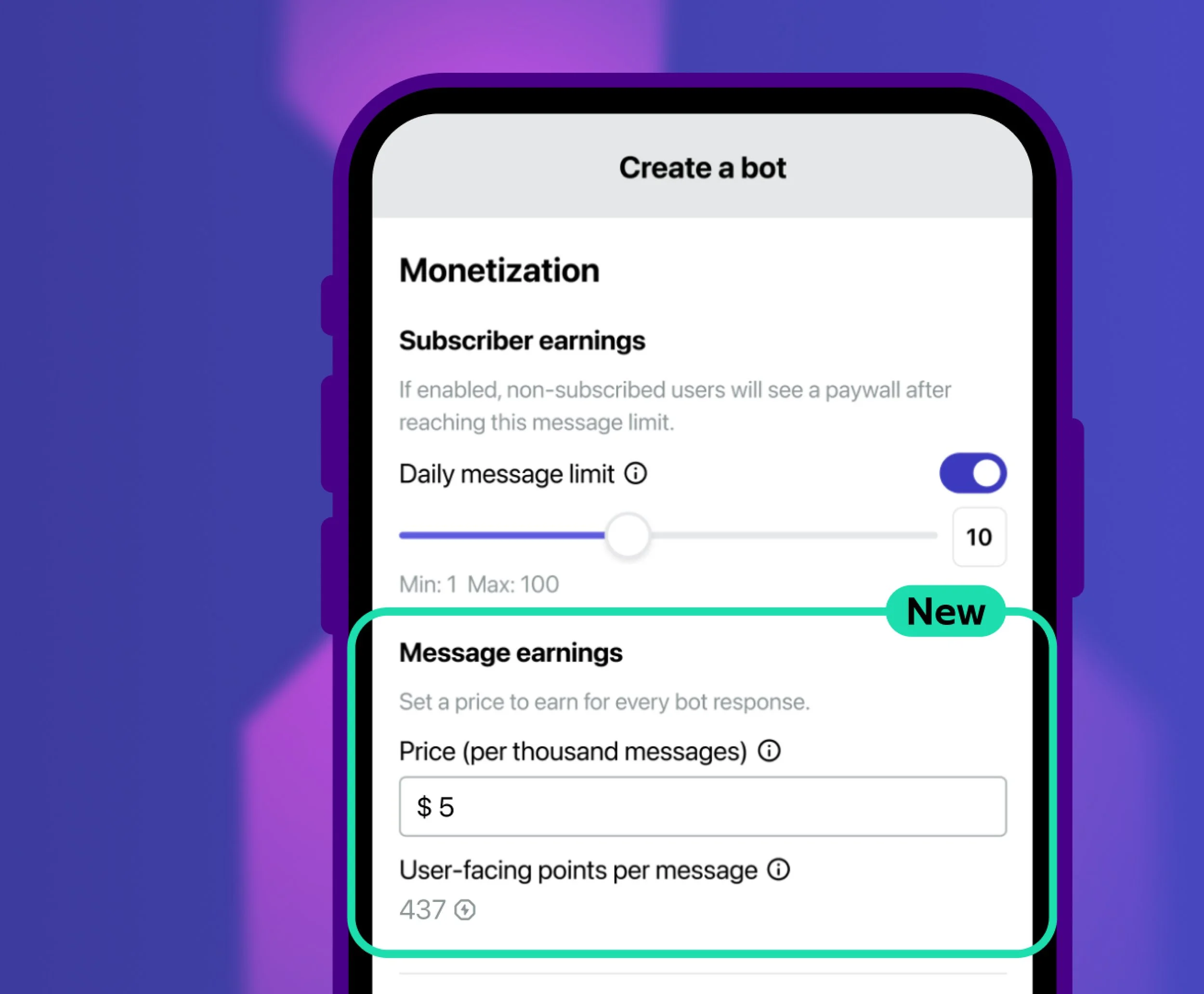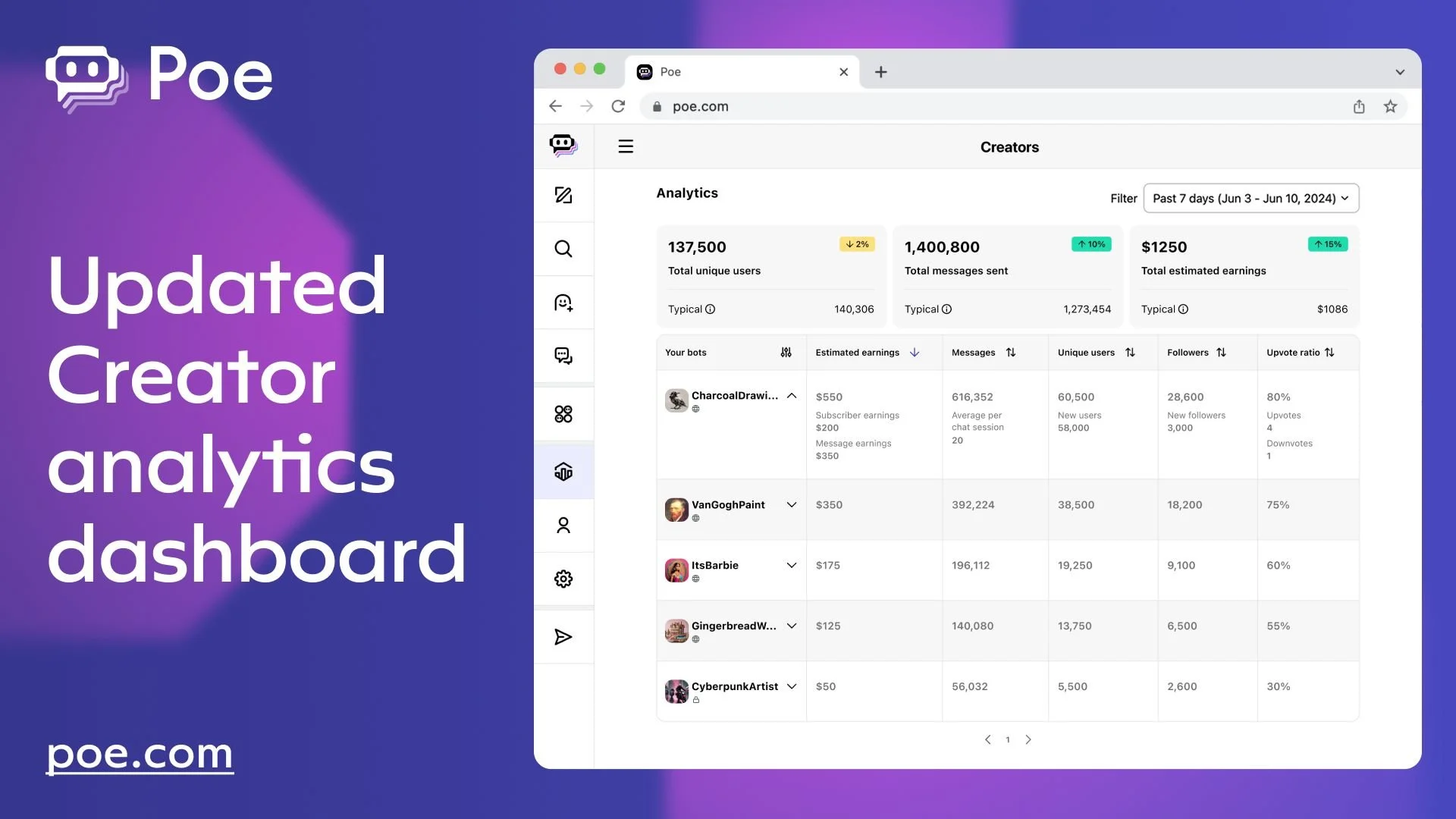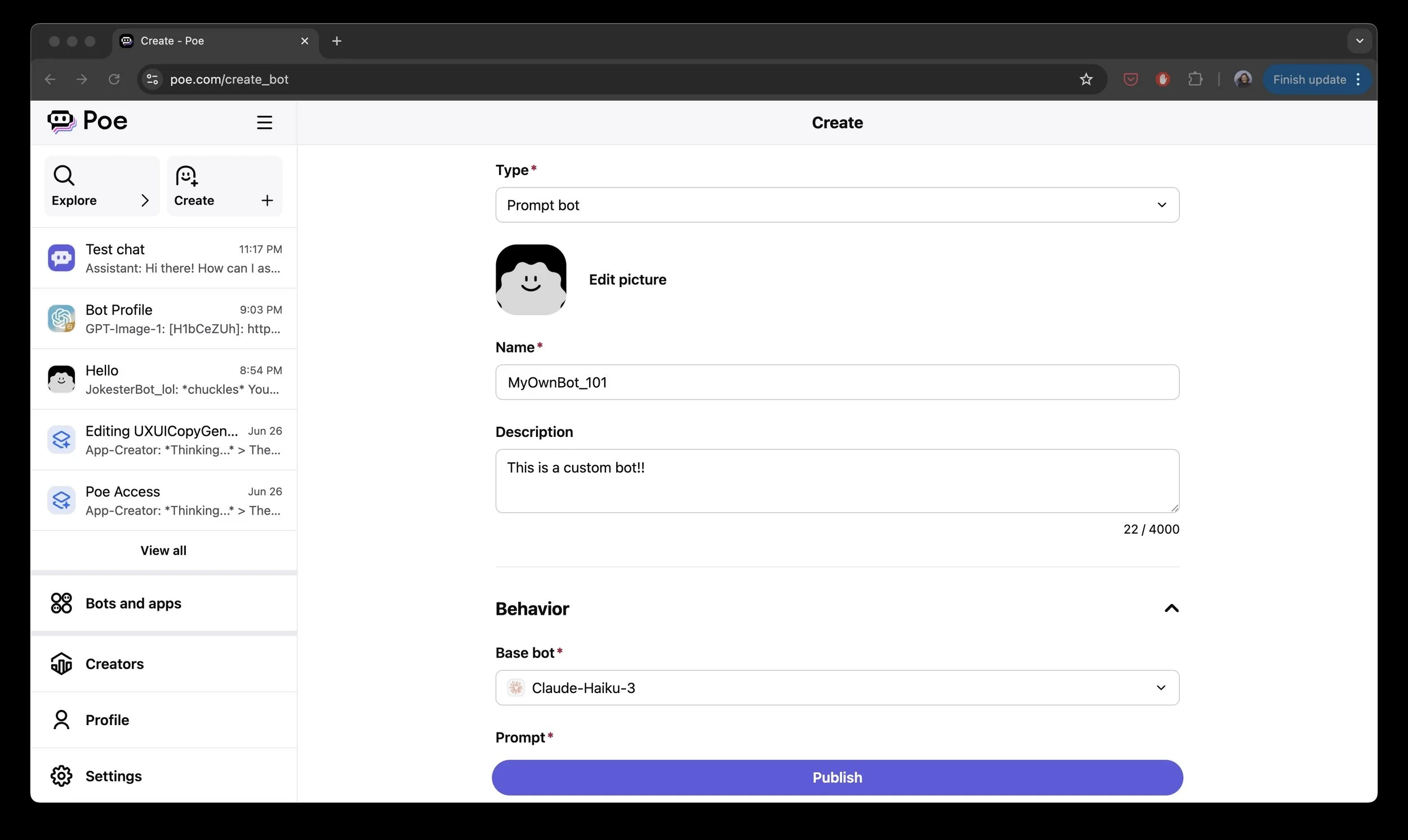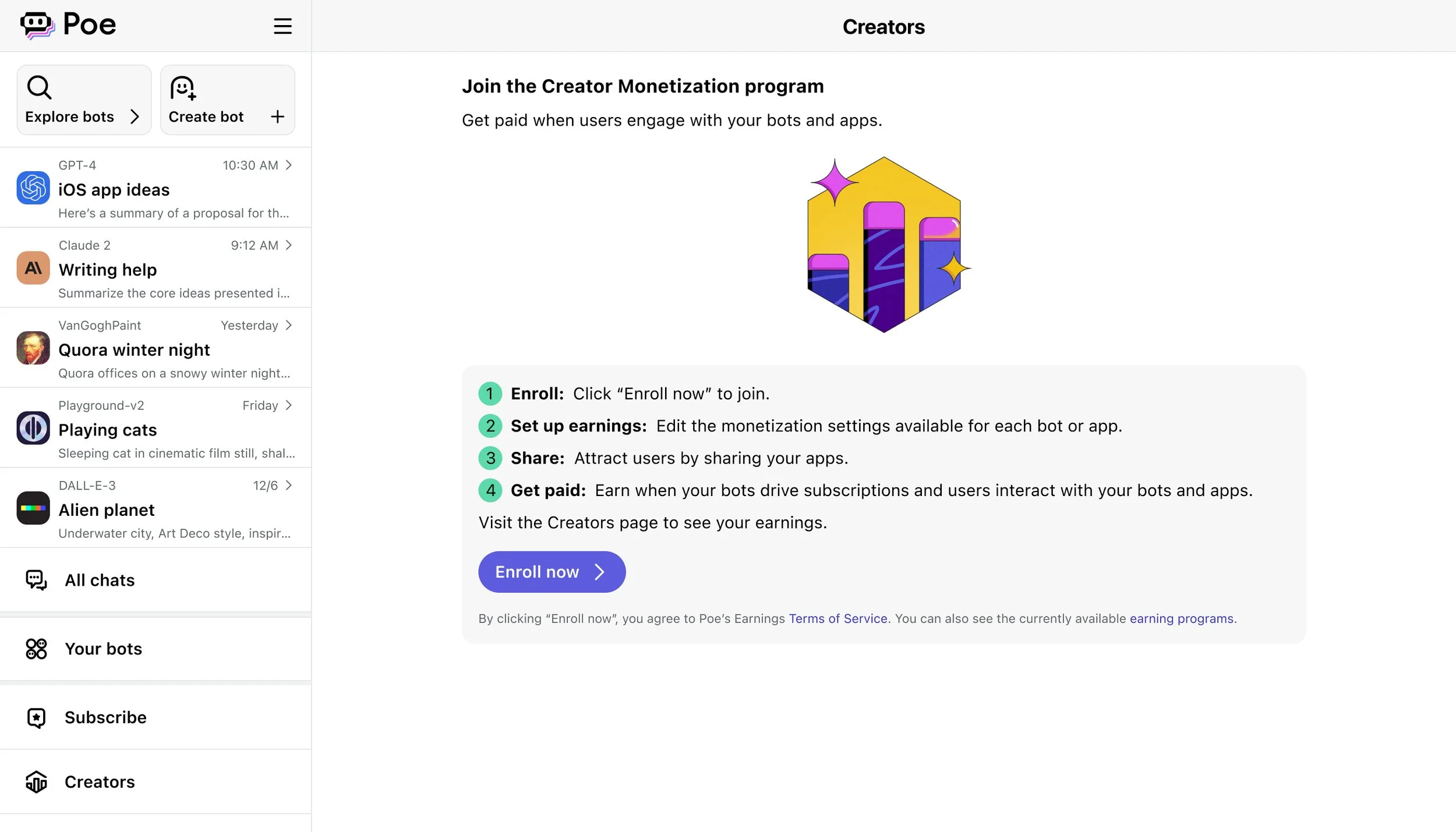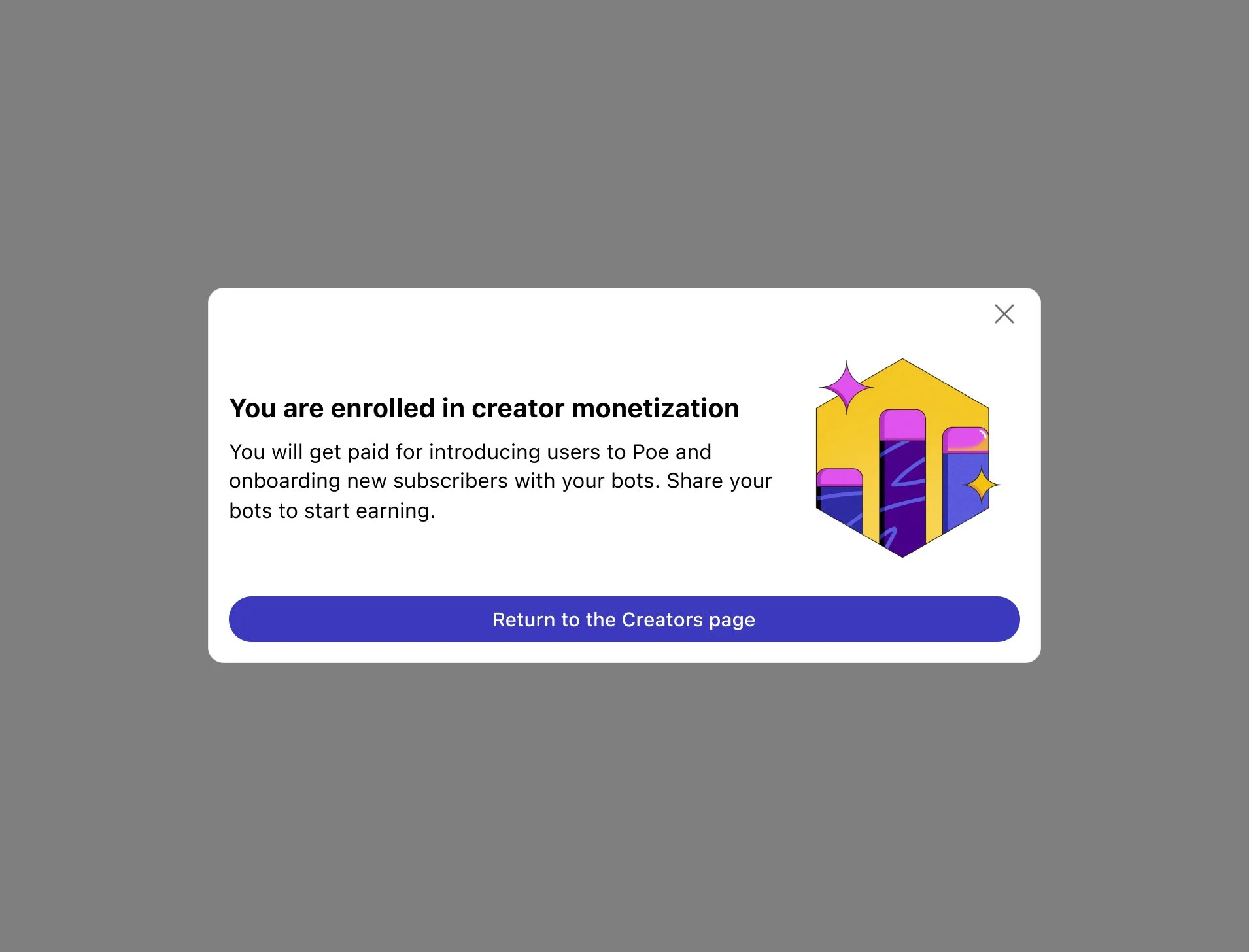Enabling AI chatbot and app creators on Poe to monetize their creations
Poe Creator Earnings
Overview
Role: Lead Designer
Company: Quora (Poe Monetization)
Team: 1 Designer, 1 Product Manager, 1 UX Researcher, 1 Data Scientist, 1 Software Engineer
Timeline: Phased launch between October 2023 - March 2024
Deliverables:
Creator-facing monetization tools (per-message pricing and paywall settings)
Bot performance and earnings analytics
Creator onboarding and payout setup
Results:
Since launch, this earnings program has attracted tens of thousands of creators, generated substantial payouts, and driven notable subscriber growth.
Background
What’s Poe?
Poe gives you access to the best AI from many different companies in a single interface across all of your devices. ChatGPT, Claude 3.7 Sonnet, DeepSeek R1, many of the top image, video, and audio generation models, and millions of user-created bots are all on Poe.
As a creator on Poe, you can prompt engineer on top of the models we offer to create unique chatbot experiences.
A peek at the results…
As lead designer on Poe’s Monetization team, I designed and launched Poe’s creator earnings program, which allows AI bot creators to earn money through two models:
Subscriber earnings: Creators earn when a user subscribes to Poe after hitting their bot’s paywall or following their share link.
Message earnings: Creators set a per-message price and get paid when users message their bots.
User flow: creating a bot on Poe
Here are the screens a user traverses as they create a bot on Poe
From the Poe homepage, click "Create" at the top of the main menu.
First, the user needs to decide which type of bot to create.
Next, the user fills in all the bot details.
Finally, the user can chat with their new bot!
Planning
I kickstarted this project by collaborating with:
The Poe UX Researcher to better understand our creators
The Monetization PM to define our business and product goals
An Engineer and Data Scientist to understand technical constraints
User research
Study goals
My UXR partner and I defined a survey to share with Poe creators:
What motivates creators to build on Poe?
How do creators define success?
What metrics do creators need?
The outcome of this study helped us hone in on our user goals and define what features and analytics our earnings program required.
Key insights
Motivations:
Lack of availability of desired bots, curiosity about AI capabilities, and the need to improve productivity were leading motivators.
If monetization were available, it would have a very strong effect on their decision to create more bots.
Definitions of success:
Reactions (thumbs up, thumbs down, etc.) to bot messages
Bot rankings (appearing in the “recommended bots” section)
Desired bot metrics:
Messages sent
Unique users
Share count
Trend reports (changes in followers, users, messages, etc.)
Product specifications
Problem space
Creators were building incredible bots, but had no way to earn from them. Some developers were even covering API costs out of pocket. We needed to build a monetization system that:
Works for everyone, from casual creators to experienced developers
Encourages sharing and virality
Is trustworthy, transparent, and easy to use
Helps creators build a sustainable income over time
Business goals
The earnings program needs to:
Scale with our existing monetization infrastructure.
Our system relies on paywalls to attract subscribers.
Users spend compute points, our internal Poe currency, to message bots.
Be sustainable and work with our product’s margin goals.
User goals
Allow creators to earn when their bots attract subscribers (Subscriber earnings)
Allow creators to earn when users interact with their bots (Message earnings)
Provide creators with actionable analytics to improve their bots
Constraints
We needed to maintain a small technical scope since we had a single engineer booked on this project.
At the same time, developer velocity is vital! Our top goal was to enable creators to earn ASAP. We planned to iteratively improve the program based on user feedback.
Design
We designed, developed, and launched this project in phases:
Starting with subscriber earnings
Following with engagement earnings
And tying everything up with creator analytics
Subscriber earnings
User goal
Creators can set a message limit to control when users see a paywall.
When a user subscribes after hitting a paywall, that creator earns a portion of the revenue.
Design
Add a Monetization section to the bot creation form.
Provide a slider that allows creators to set a daily message limit for their bot.
Follow the design patterns on the rest of the page and use components from our design system.
Message earnings
User goal
Creators can set a price per-message on each bot.
Creators understand how this influences the message cost of their bot.
Design
Add a text input field to the Monetization section on the bot creation form that allows creators to define an additional price-per-message.
Dynamically update the user-facing bot cost to include this price.
The updated “Create Bot” page with the new Monetization section!
Let’s experience the full flow
After a few iterations, critique from my design team, and some speedy coding, we launched our initial earnings programs!
Onboarding and payouts
Enrolling in the program
We built a Creators page on Poe to serve as the foundation for all future creator tooling.
I included an informational card explaining the program with an engaging graphic and clear CTA to enroll.
Getting paid $$$
After enrolling, a persistent dynamic banner appears on the Creators page, encouraging creators to connect to Stripe to receive payouts.
Creator analytics
Competitive research
I perused popular creator platforms, such as YouTube and Twitch, and spoke to some creators to better understand common data analytics patterns.
These products:
Displayed data highlights, such as averages and trends
Presented account-level and content-level data
Had engaging data visualizations
Offered time-based filtering
Visual explorations
I went wild with some ideas, pretending I had no technical constraints!
Elaborate graphs visualizing performance
Customized highlights explaining account performance
Many interactive filters and hierarchies of data
A selection of my wireframes…


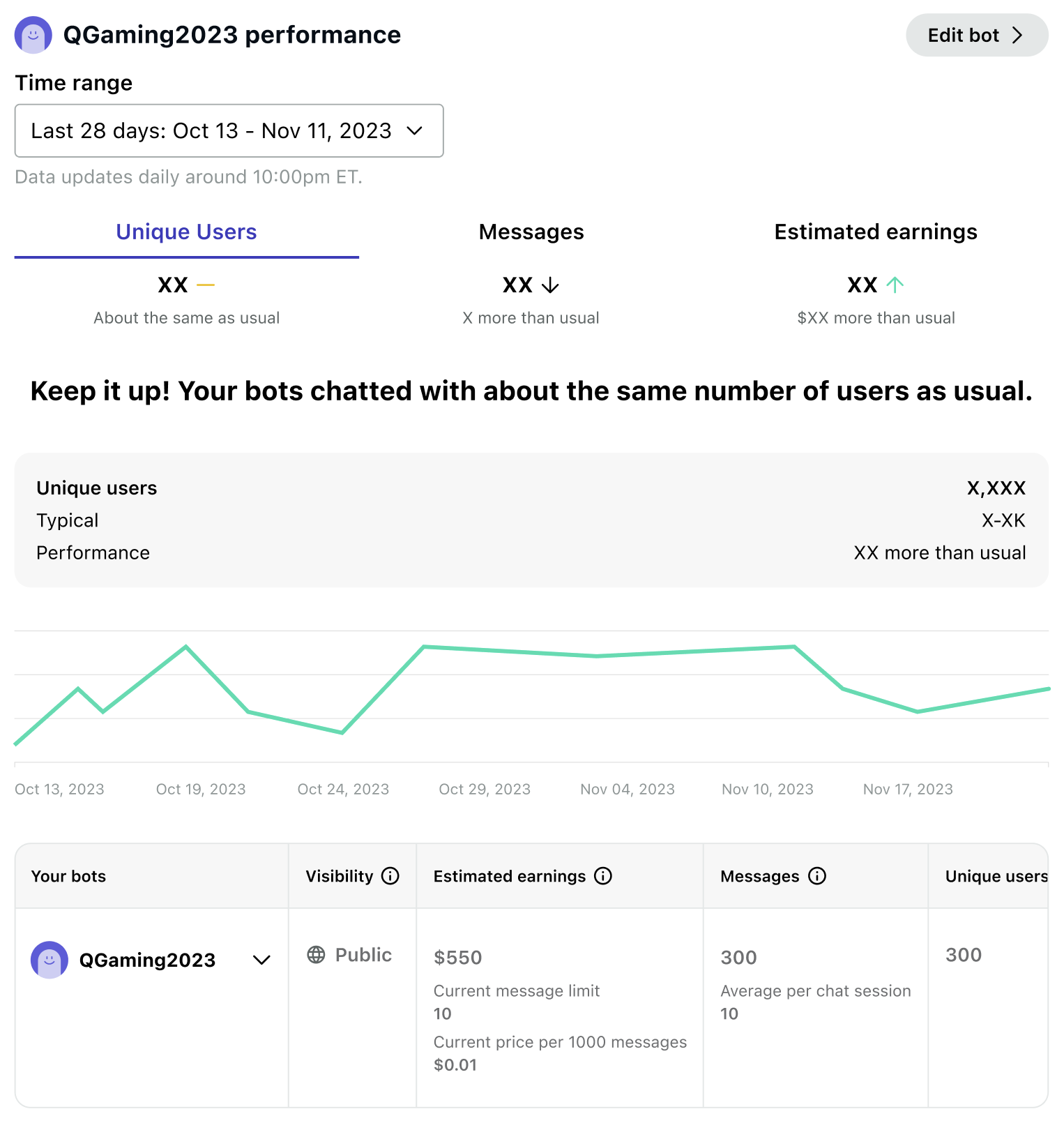
Refining the design
Based on feedback from my team and the constraints of our development timeline, I pared back my design by honing in on the most important features:
A single analytics table listing all of the available bot data
Time-based filtering
Summary cards that highlight typical performance and trends
The most pertinent data: earnings, messages, unique users, followers, and upvote ratio
Interaction details:
Click on a table row to expand it and view a more detailed breakdown.
Click on the bot name to open a bot-specific view.
Click on the arrows next to each column header to sort.
Filter by day, week, month, or year to understand your trends across different time frames.
Let’s experience the full flow
Featuring some mock creator performance and earnings data
Outcome
Results
Media recognition
The subscriber earnings and engagement earnings launches were both covered by TechCrunch!
Adoption
Since launch, our earnings program has attracted tens of thousands of creators, generated substantial payouts, and driven notable subscriber growth.
It has proven to be beneficial for both creators are our business model.
Importance of monetization
We surveyed creators again after the launch of our earnings program and performance analytics.
When asked How much does monetization (ability to make money from bots) affect your decision to create bots? creators responded:
Reflection
Next steps
Expand to more countries (creators across the world are requesting access!).
Expand the analytics table to display even more data requested by creators.
Include more personalized analytics highlights and tips on how to optimize their monetization settings based on bot performance.
Personal lessons
Metering the launch process into phases helped us limit scope, improve development velocity, and monitor feedback from creators. This is a model I’ll bring into future projects.
Scoping designs early on with technical partners (engineering and data science) helped me build a feasible solution from the start.

